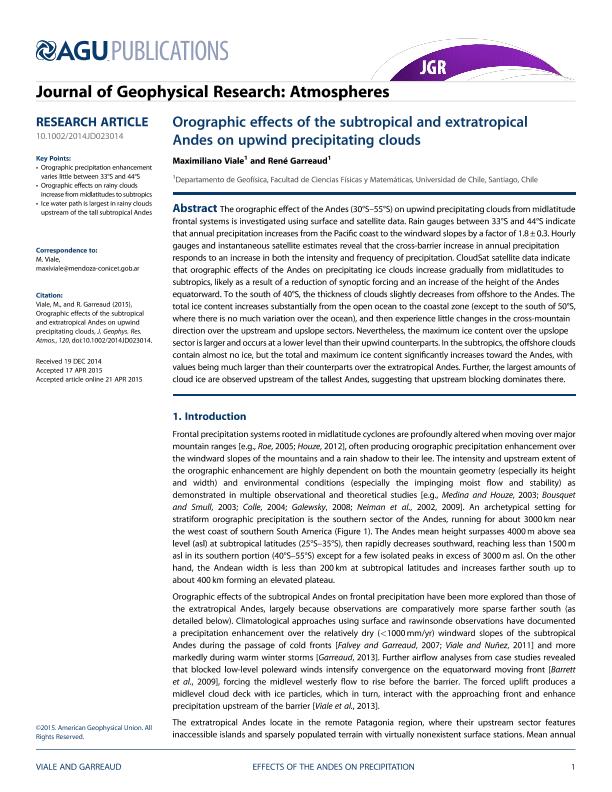Mostrar el registro sencillo del ítem
dc.contributor.author
Viale, Maximiliano

dc.contributor.author
Garreaud, René
dc.date.available
2018-09-12T20:11:37Z
dc.date.issued
2015-05
dc.identifier.citation
Viale, Maximiliano; Garreaud, René; Orographic effects of the subtropical and extratropical andes on upwind precipitating clouds; American Geophysical Union; Journal of Geophysical Research; 120; 10; 5-2015; 4962-4974
dc.identifier.issn
0148-0227
dc.identifier.uri
http://hdl.handle.net/11336/59438
dc.description.abstract
The orographic effect of the Andes (30°S–55°S) on upwind precipitating clouds from midlatitude frontal systems is investigated using surface and satellite data. Rain gauges between 33°S and 44°S indicate that annual precipitation increases from the Pacific coast to the windward slopes by a factor of 1.8 ± 0.3. Hourly gauges and instantaneous satellite estimates reveal that the cross-barrier increase in annual precipitation responds to an increase in both the intensity and frequency of precipitation. CloudSat satellite data indicate that orographic effects of the Andes on precipitating ice clouds increase gradually from midlatitudes to subtropics, likely as a result of a reduction of synoptic forcing and an increase of the height of the Andes equatorward. To the south of 40°S, the thickness of clouds slightly decreases from offshore to the Andes. The total ice content increases substantially from the open ocean to the coastal zone (except to the south of 50°S, where there is no much variation over the ocean), and then experience little changes in the cross-mountain direction over the upstream and upslope sectors. Nevertheless, the maximum ice content over the upslope sector is larger and occurs at a lower level than their upwind counterparts. In the subtropics, the offshore clouds contain almost no ice, but the total and maximum ice content significantly increases toward the Andes, with values being much larger than their counterparts over the extratropical Andes. Further, the largest amounts of cloud ice are observed upstream of the tallest Andes, suggesting that upstream blocking dominates there.
dc.format
application/pdf
dc.language.iso
eng
dc.publisher
American Geophysical Union

dc.rights
info:eu-repo/semantics/openAccess
dc.rights.uri
https://creativecommons.org/licenses/by-nc-sa/2.5/ar/
dc.subject
Precipitating Clouds
dc.subject
Orographic Effects
dc.subject
Andes
dc.subject
Stratiform Precipitation
dc.subject.classification
Meteorología y Ciencias Atmosféricas

dc.subject.classification
Ciencias de la Tierra y relacionadas con el Medio Ambiente

dc.subject.classification
CIENCIAS NATURALES Y EXACTAS

dc.title
Orographic effects of the subtropical and extratropical andes on upwind precipitating clouds
dc.type
info:eu-repo/semantics/article
dc.type
info:ar-repo/semantics/artículo
dc.type
info:eu-repo/semantics/publishedVersion
dc.date.updated
2018-08-28T19:04:22Z
dc.journal.volume
120
dc.journal.number
10
dc.journal.pagination
4962-4974
dc.journal.pais
Estados Unidos

dc.journal.ciudad
Washington
dc.description.fil
Fil: Viale, Maximiliano. Consejo Nacional de Investigaciones Científicas y Técnicas; Argentina. Universidad de Chile; Chile
dc.description.fil
Fil: Garreaud, René. Universidad de Chile; Chile
dc.journal.title
Journal of Geophysical Research

dc.relation.alternativeid
info:eu-repo/semantics/altIdentifier/doi/https://dx.doi.org/10.1002/2014JD023014
dc.relation.alternativeid
info:eu-repo/semantics/altIdentifier/url/https://agupubs.onlinelibrary.wiley.com/doi/abs/10.1002/2014JD023014
Archivos asociados
